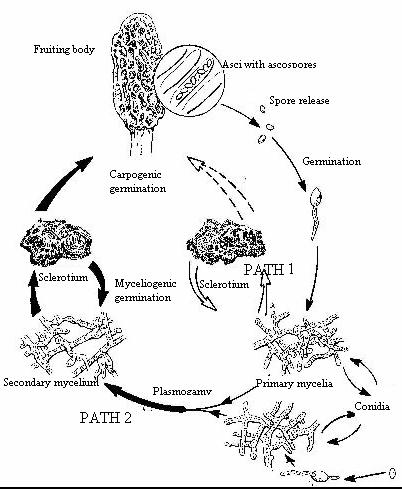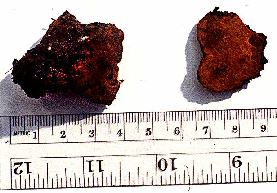 Reproduction
Reproduction
Path 1: When the fruiting body is
above ground and senses the light, the spores on the
asci are released and germinated. Once the fungi has
germinated itself through asexual reproduction the
primary mycelia then produces a sclerotium which in
turn produces the fruiting body of the morel (the
edible part) which will then repeat the process.
However, if conditions become suitable for sexual
reproduction, the sclerotium can then convert back
to the primary mycelia to go through the process of
plasogamy.
Path 2: This path starts out the same way as path 1, but it is quite different. Once the germinated spores become the primary mycelia, they begin the process or plasmogamy with another morel's primary mycelia. Plasmogamy is the sexual reproductive cycle in which the cytoplasm of two parent mycelia fuse together while at the same time not fusing the nuclei. When plasmogamy occurs, it forms a secondary mycelium which contains dikaryotic (meaning two nuclei) cells. The secondary mycelium then produces a sclerotium which in turn using carpogenic germination produces the fruiting body of the morel which then will repeat the process once again. However, if the correct conditions don't occur for the fungi to produce a fruiting body above ground, the sclerotium could go through the process of myceliogenic germination. This process causes the hypae to grow towards the roots of the host.
Path 2: This path starts out the same way as path 1, but it is quite different. Once the germinated spores become the primary mycelia, they begin the process or plasmogamy with another morel's primary mycelia. Plasmogamy is the sexual reproductive cycle in which the cytoplasm of two parent mycelia fuse together while at the same time not fusing the nuclei. When plasmogamy occurs, it forms a secondary mycelium which contains dikaryotic (meaning two nuclei) cells. The secondary mycelium then produces a sclerotium which in turn using carpogenic germination produces the fruiting body of the morel which then will repeat the process once again. However, if the correct conditions don't occur for the fungi to produce a fruiting body above ground, the sclerotium could go through the process of myceliogenic germination. This process causes the hypae to grow towards the roots of the host.
The sclerotium is a hard mass of mycelium cells which is created to help protect the fungi underground during harsh conditions. When the conditions are right, the sclerotium will produce the fruiting bodies of the fungi in either myceliogenic germinations (towards the root) or carpogenic germinations (above ground) in which to start the process of reproduction once again.

As seen above, the fruiting body contains asci the houses the spores. To the right is a picture of the spores on the asci of the morel mushroom. When the conditions are right, the spores from the asci are released to be germinated.
For more information on the morel's life cycle, check out Tom Volk's Morel Page!
